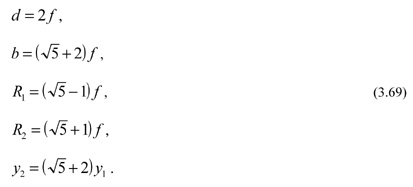Optipedia • SPIE Press books opened for your reference.
Schwarzschild Objective
Excerpt from Optical Design Fundamentals for Infrared Systems, Second Edition
If the two spherical mirrors are concentric to each other, separated by twice the system's focal length, third-order spherical aberration, coma and astigmatism are eliminated, provided the aperture stop is located at the common center of curvature c as shown in the figure below. Adding a thin field flattener lens in the focal plane corrects for distortion and field curvature as well.

The concentric Schwarzschild objective with field flattener.
The specific relations to achieve the corrections of spherical aberration, coma, and astigmatism are

The Petzval radius is, according to Eq. (3.62), ρ = −f. To correct for this effect, we insert a field lens whose Petzval radius is +f. Since the function of this field lens is to “flatten” the image in the field, it is called a field flattener. By applying Eq. (3.12) to calculate the focal length of the field flattener, we obtain

where N is the index of refraction for the field flattener lens, and f is the focal length of the Schwarzschild objective. By placing the field flattener in the plane of the image, the lens can be shaped as stated in Eqs. (3.71) and (3.72) to eliminate distortion.1

With a high-index material, such as N = 4 for germanium, R4 becomes 15 times the focal length. This suggests substitution of a flat surface and correction of R3 for power. Not only would this lower the cost of the lens, but it invites the idea of depositing the detector elements directly onto the rear surface of the field flattener.
For further study, including the aberrations for finite conjugate configurations, see Ref. 2.
References
- R. Kingslake, Lens Design Fundamentals, Academic Press (1978), page 208.
- I. A. Artioukov and K. M. Krymski, “Schwarzschild objective for soft x-rays,” Optical Engineering 39, No. 8, pages 2163–2170.
M. Riedl, Optical Design Fundamentals for Infrared Systems, Second Edition, SPIE Press, Bellingham, WA (2001).
View SPIE terms of use.
Non-Member: $58.00

